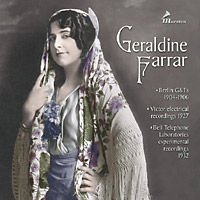A Note from Ward Marston
Geraldine Farrar
Geraldine Farrar made her first records in Berlin for the Gramophone and Typewriter Ltd. in 1904. Although the exact recording dates are unknown, discographic sources indicate that nineteen sides were recorded over three or possibly four sessions. These comprised fifteen titles and four re-takes. All nineteen sides were assigned catalogue numbers and ostensibly published, though to my knowledge, only eleven have ever surfaced. These 1904 G&Ts are unquestionably Farrar’s rarest records and most of the extant copies are only in average condition. The Manon “Gavotte” is particularly scarce and, unfortunately, both available copies possessed worn grooves causing severe noise on Farrar’s loudest notes. Especially notable among these recordings are the excerpts from Leoncavallo’s opera Roland, often referred to in error as Roland von Berlin. Sadly, only five sides have come to light, although twelve were actually recorded. These included two solos plus seven duets and three re-takes with tenor Wilhelm Grüning. The extant sides are presented here in musical sequence rather than by matrix. It should also be mentioned that two sides were transposed down a semi-tone presumably for the comfort of Heir Grüning. Over the following two years, Geraldine Farrar recorded an additional fourteen sides all of which were published and are presented here in matrix order. Taken as a group, Geraldine Farrar’s G&T discs are undoubtedly her finest recordings. Despite the limitations of acoustic recording, these discs convey the force of Farrar’s magnetic personality which was to be a hallmark of her persona throughout her professional career. They also allow us to hear the buoyant vitality of her voice which, alas, would fade all too soon.
Farrar made her final Metropolitan Opera appearance in 1922 and her last published Victor recording in 1923. With the advent of electrical recording, however, she entered the Victor recording studio again for one last group of recording sessions. Between January and April, 1927, she recorded 35 sides comprising multiple takes of thirteen titles. Although these recordings were all rejected for issue at the time, during the 1930s, the International Record Collector’s Club published four sides from the original masters and two others as re-recordings from Farrar’s own test pressings. Many of these pressings still survive and only two of the thirteen recorded titles have disappeared. The present edition contains one take of each surviving title and two re-takes. Mendelssohn’s “Auf Flügeln des Gesanges” is presented twice since Farrar sings one in English and the other in German. It should also be noted that the piano accompaniments for these two versions differ slightly. Two takes of “Pur dicesti” have also been included because of the differences in Farrar’s performances.
Five years later, Geraldine Farrar recorded four songs for the Bell Telephone Laboratories who, at that time, were experimenting with high fidelity recording technology. These Farrar discs were vertically cut at a speed of 33 rpm. No one knows exactly how and why this recording session was arranged but it seems plausible that Bell Laboratories intended the recordings for publicity purposes. Although Farrar’s voice is in serious decline by this point, it is, nonetheless, fascinating to hear it so faithfully reproduced. (Incidentally, two other noted singers who made recordings for Bell Labs were soprano Elisabeth Rethberg and baritone Nelson Eddie.) The sound of these Bell Laboratories recordings is quite stupendous and one can only wonder why fifteen years would pass before commercial record companies would begin producing recordings of comparable quality.
Next come two songs from a 1934 broadcast that may well be Farrar’s last radio concert appearance. These items were recorded off the air via a primitive home recording system, hence the very poor sound quality. A third song from this broadcast, Fritz Kreisler’s “Liebesleid,” was also recorded, but the quality is too poor for inclusion here.
During the Metropolitan Opera’s 1934-35 broadcast season, Geraldine Farrar was invited to give intermission talks over the air. As an additional feature, Farrar sang short musical fragments accompanying herself at the piano. This set concludes with excerpts from a rehearsal recording of Miss Farrar practicing her intermission talks for the 5 January broadcast of Verdi’s La Traviata. These charming reminiscences of Geraldine Farrar’s early career will, I hope, serve as a fitting conclusion to this compendium.

Geraldine Farrar
- Berlin G&Ts 1904-1906
- Victor electrical recordings 1927
- Bell Telephone Laboratories experimental recordings 1932
Geraldine Farrar was, for many years, the prima donna assoluta of the Metropolitan Opera. She is remembered as having one of the best soprano voices of her time and yet, those who know her through her recorded output on Victor, are missing the magic that is Farrar. This two CD set, instead, captures Farrar when she made her earliest, finest, and scarcest recordings for G & T (1904-1906). These rare and stunning recordings are fresh, exciting, and expressive and demonstrate Farrar in “best voice.” This set also chronicles Farrar at the end of her career when technology provided an opportunity to hear her “true” voice during the 1920s and 1930s. While none of these were issued at the time, these test pressings and unpublished Bell Laboratory test-recordings of 1934 provide a glimpse of her brilliance.